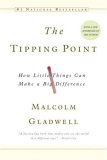Summary | Excerpt | Reviews | Readalikes | Genres & Themes | Author Bio

Critics' Opinion:
Readers' Opinion:
First Published:
Feb 2000, 279 pages
Paperback:
Dec 2001, 304 pages
Chapter One
The Three Rules of Epidemics
In the mid-1990s, the city of Baltimore was attacked by an epidemic of syphilis. In the space of a year, from 1995 to 1996, the number of children born with the disease increased by 500 percent. If you look at Baltimore's syphilis rates on a graph, the line runs straight for years and then, when it hits 1995, rises almost at a right angle.
What caused Baltimore's syphilis problem to tip? According to the Centers for Disease Control, the problem was crack cocaine. Crack is known to cause a dramatic increase in the kind of risky sexual behavior that leads to the spread of things like HIV and syphilis. It brings far more people into poor areas to buy drugs, which then increases the likelihood that they will take an infection home with them to their own neighborhood. It changes the patterns of social connections between neighborhoods. Crack, the CDC said, was the little push that the syphilis problem needed to turn into a raging epidemic.
John Zenilman of Johns Hopkins University in Baltimore, an expert on sexually transmitted diseases, has another explanation: the breakdown of medical services in the city's poorest neighborhoods. "In 1990-91, we had thirty-six thousand patient visits at the city's sexually transmitted disease clinics," Zenilman says. "Then the city decided to gradually cut back because of budgetary problems. The number of clinicians [medical personnel] went from seventeen to ten. The number of physicians went from three to essentially nobody. Patient visits dropped to twenty-one thousand. There also was a similar drop in the amount of field outreach staff. There was a lot of politics — things that used to happen, like computer upgrades, didn't happen. It was a worst-case scenario of city bureaucracy not functioning. They would run out of drugs."
When there were 36,000 patient visits a year in the STD clinics of Baltimore's inner city, in other words, the disease was kept in equilibrium. At some point between 36,000 and 21,000 patient visits a year, according to Zenilman, the disease erupted. It began spilling out of the inner city, up the streets and highways that connect those neighborhoods to the rest of the city. Suddenly, people who might have been infectious for a week before getting treated were now going around infecting others for two or three or four weeks before they got cured. The breakdown in treatment made syphilis a much bigger issue than it had been before.
There is a third theory, which belongs to John Potterat, one of the country's leading epidemiologists. His culprits are the physical changes in those years affecting East and West Baltimore, the heavily depressed neighborhoods on either side of Baltimore's downtown, where the syphilis problem was centered. In the mid-1990s, he points out, the city of Baltimore embarked on a highly publicized policy of dynamiting the old 1960s-style public housing high-rises in East and West Baltimore. Two of the most publicized demolitions — Lexington Terrace in West Baltimore and Lafayette Courts in East Baltimore — were huge projects, housing hundreds of families, that served as centers for crime and infectious disease. At the same time, people began to move out of the old row houses in East and West Baltimore, as those began to deteriorate as well.
"It was absolutely striking," Potterat says, of the first time he toured East and West Baltimore. "Fifty percent of the row houses were boarded up, and there was also a process where they destroyed the projects. What happened was a kind of hollowing out. This fueled the diaspora. For years syphilis had been confined to a specific region of Baltimore, within highly confined sociosexual networks. The housing dislocation process served to move these people to other parts of Baltimore, and they took their syphilis and other behaviors with them."
What is interesting about these three explanations is that none of them is at all dramatic. The CDC thought that crack was the problem. But it wasn't as if crack came to Baltimore for the first time in 1995. It had been there for years. What they were saying is that there was a subtle increase in the severity of the crack problem in the mid-1990s, and that change was enough to set off the syphilis epidemic. Zenilman, likewise, wasn't saying that the STD clinics in Baltimore were shut down. They were simply scaled back, the number of clinicians cut from seventeen to ten. Nor was Potterat saying that all Baltimore was hollowed out. All it took, he said, was the demolition of a handful of housing projects and the abandonment of homes in key downtown neighborhoods to send syphilis over the top. It takes only the smallest of changes to shatter an epidemic's equilibrium.
© 2000 by Malcolm Gladwell





The House on Biscayne Bay
by Chanel Cleeton
As death stalks a gothic mansion in Miami, the lives of two women intertwine as the past and present collide.

The Flower Sisters
by Michelle Collins Anderson
From the new Fannie Flagg of the Ozarks, a richly-woven story of family, forgiveness, and reinvention.

The Funeral Cryer by Wenyan Lu
Debut novelist Wenyan Lu brings us this witty yet profound story about one woman's midlife reawakening in contemporary rural China.
Your guide toexceptional books
BookBrowse seeks out and recommends the best in contemporary fiction and nonfiction—books that not only engage and entertain but also deepen our understanding of ourselves and the world around us.